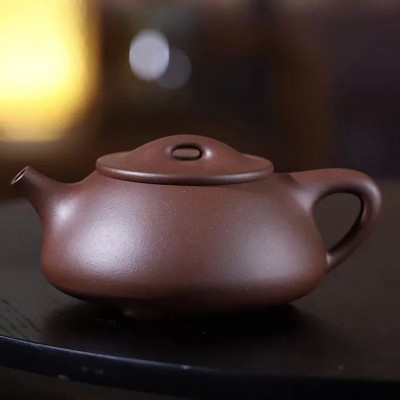





"Shipiao" Yixing teapot- this zisha teapot is a traditional Chinese tea set characterized by its gourd-like or calabash-like shape, with a small top and large bottom, a sturdy and short spout, and a pyramid-shaped body that exudes elegance. Made from high-quality purple clay material, this teapot is known for its hardness and durability, as well as its stable and easy-to-use design. The short and powerful straight spout ensures a smooth and steady flow of water, while the pyramid-shaped body adds a touch of sophistication to any tea ceremony.
 Delivery
Delivery
Free shipping within 1 to 3 days. ETA:5-7 days
 Returns
Returns
Within 28 days after delivery date.
 Security
Security
SSL | GDRP used to ensure information security.
Guarantee safe & secure checkout
Data sheet
This yixing teapot is a true gem. The craftsmanship is exquisite, and the functionality is outstanding. The lid fits perfectly, and the pour is smooth and controlled. It has quickly become my go-to teapot for enjoying a peaceful cup of tea. I couldn't be happier with my purchase and highly recommend it to anyone looking for a high-quality teapot.
I recently purchased this yixing teapot, and I am thoroughly impressed with its perfect size and elegant design. It's just right for brewing a few cups of tea, and the clay material gives it a unique appeal. The pour is smooth and precise, making it a pleasure to use. It has quickly become an essential part of my tea-drinking routine, and I highly recommend it to all tea enthusiasts.
"wendan" in Chinese refers to softness, appearance, and demeanor, while "dan" refers to the female roles in traditional Chinese opera. To literati, the charm and style of the "wendan" teapot are comparable to the beauty of a woman's shoulder, soft and boneless, like the alluring curves of "Xishi", exuding a natural grace and charm. The "wen" in "wendan" represents the soft, delicate appearance of the teapot, while the "dan" represents the feminine qualities that the teapot embodies. The "wendan" teapot is highly valued for its unique and elegant shape, which exudes a natural beauty and grace that is reminiscent of the beauty of a woman.
"De" means morality,"zhong" means "bell",The bell-shaped lid and body of this zisha teapot symbolize a person with noble character, frugality, and simplicity. Owning this teapot is seen as a sign of being a true gentleman, as it represents the values of humility and refinement.
"Fanggu" Yixing Teapot - This zisha teapot has an antique cylindrical body shaped like a drum, with a short neck imitating the shape of a drum pot. The spout is also designed to imitate the shape of a drum pot spout, with a straight line. Its advantages include excellent heat preservation, natural color, comfortable texture, and long service life. The "Fanggu" teapot is a unique and elegant choice for tea lovers and collectors alike.
As a shape, "Ruyi" is a common pattern and object shape in traditional Chinese culture,the "Ruyi" shape represents auspicious, happiness, and good meanings in Chinese culture.
"Lianzi" means Lotus Seed, "lianzi" family has various shapes and forms, which reflects the Buddhist saying "Lotus originates from the heart, and the heart gives rise to infinite forms." the shape of the Lotus Seed was characterized by a straight mouth, drooping shoulders, circular feet, and a round and bulging body with a slightly bulging cover, resembling a lotus seed. Over time, the design evolved from being simple and rustic to being elegant and graceful, with the lid raised and adorned with a bead knob, making it look more towering. A small spout gracefully protrudes from the shoulder of the pot, while the handle is shaped like a woman's arm in a graceful and elegant stance.
"Shipiao" Yixing teapot- this zisha teapot is a traditional Chinese tea set characterized by its gourd-like or calabash-like shape, with a small top and large bottom, a sturdy and short spout, and a pyramid-shaped body that exudes elegance. Made from high-quality purple clay material, this teapot is known for its hardness and durability, as well as its stable and easy-to-use design. The short and powerful straight spout ensures a smooth and steady flow of water, while the pyramid-shaped body adds a touch of sophistication to any tea ceremony.
"Meirenjian" yixing teapot resembles an ancient woman, dignified and lovely, with a hint of palace elegance and grace, yet without losing the charm of a young lady. The shape is full and elegant, mainly reflecting the roundness of the pot body. The pot cover and the pot body seem to be integrated without any gaps. When touched by hand, one can feel its warmth.
"Duozhi" yixing teapot is a unique and distinctive shape in the world of Yixing zisha teapots. Its shape resembles a pile of spheres and hemispheres stacked together, giving it a unique and eye-catching appearance. The name "Duo Zhi" comes from the Chinese word for "stacking and linking." Due to its unique appearance, this type of teapot is commonly referred to as the "Duozhi teapot." Interestingly, the name "Duozhi" in Chinese also carries a positive connotation, meaning "many children, much happiness." This adds to the charm and appeal of this teapot, making it a popular choice for collectors and tea enthusiasts alike.
"De" means morality,"zhong" means "bell",The bell-shaped lid and body of this zisha teapot symbolize a person with noble character, frugality, and simplicity. Owning this teapot is seen as a sign of being a true gentleman, as it represents the values of humility and refinement.
"Shipiao" Yixing teapot- this zisha teapot is a traditional Chinese tea set characterized by its gourd-like or calabash-like shape, with a small top and large bottom, a sturdy and short spout, and a pyramid-shaped body that exudes elegance. Made from high-quality purple clay material, this teapot is known for its hardness and durability, as well as its stable and easy-to-use design. The short and powerful straight spout ensures a smooth and steady flow of water, while the pyramid-shaped body adds a touch of sophistication to any tea ceremony.
This teapot has a cute and silly appearance, so it's named "Han Piao".
The design of the Palace Lamp "Gongdeng" in the Yongzheng period of the Qing Dynasty. Its prototype was a lantern, designed by an old man from Tuntou Village. Later, the Tuntou Lantern was presented as a tribute to a county-level official who took it to the palace. The Tuntou Lantern was named "Gongdeng" and became an exclusive item for the imperial palace. Later, people replaced the character "Gong" with "Palace," and it became the "Palace Lamp" we know today. The Palace Lamp teapot is designed based on this lantern, often appearing in a square shape with a fresh, natural, and elegant style that is in line with the aesthetic views of ancient people and easily accepted by modern people.
"De" means morality,"zhong" means "bell",The bell-shaped lid and body of this zisha teapot symbolize a person with noble character, frugality, and simplicity. Owning this teapot is seen as a sign of being a true gentleman, as it represents the values of humility and refinement.
"Jizhi" yixing teapot has a straight cylindrical body with a shoulder, short neck, and straight spout. The handle is free-flowing and ear-shaped, while the lid fits tightly. The bottom of the pot is neatly crafted with exquisite workmanship. The overall design of the pot displays a strong contrast between thick and thin lines, as well as between straight and curved lines, giving it a deep, simple, and powerful temperament. At the same time, it also exudes a sense of elegance and grace. It seems that the "Jizhi" teapot conveys a spirit of honesty and justice, daring to advise others.
"Duoqiu" yixing teapot is a classic example of a geometric-style traditional round teapot and one of the finest representatives of purple clay teapots. Its basic form consists of a pot knob, pot cover, and pot body, composed of small, medium, and large spheres arranged in sequence. The pot belly is a large sphere, and the pot cover is a small sphere, giving the appearance of a small ball placed on top of a large ball, hence the name "duoqiu" teapot. This unique design creates a visually striking and aesthetically pleasing teapot that is highly prized by collectors and tea enthusiasts alike.
The design of the Palace Lamp "Gongdeng" in the Yongzheng period of the Qing Dynasty. Its prototype was a lantern, designed by an old man from Tuntou Village. Later, the Tuntou Lantern was presented as a tribute to a county-level official who took it to the palace. The Tuntou Lantern was named "Gongdeng" and became an exclusive item for the imperial palace. Later, people replaced the character "Gong" with "Palace," and it became the "Palace Lamp" we know today. The Palace Lamp teapot is designed based on this lantern, often appearing in a square shape with a fresh, natural, and elegant style that is in line with the aesthetic views of ancient people and easily accepted by modern people.
"Shipiao" Yixing teapot- this zisha teapot is a traditional Chinese tea set characterized by its gourd-like or calabash-like shape, with a small top and large bottom, a sturdy and short spout, and a pyramid-shaped body that exudes elegance. Made from high-quality purple clay material, this teapot is known for its hardness and durability, as well as its stable and easy-to-use design. The short and powerful straight spout ensures a smooth and steady flow of water, while the pyramid-shaped body adds a touch of sophistication to any tea ceremony.
"Duoqiu" yixing teapot is a classic example of a geometric-style traditional round teapot and one of the finest representatives of purple clay teapots. Its basic form consists of a pot knob, pot cover, and pot body, composed of small, medium, and large spheres arranged in sequence. The pot belly is a large sphere, and the pot cover is a small sphere, giving the appearance of a small ball placed on top of a large ball, hence the name "duoqiu" teapot. This unique design creates a visually striking and aesthetically pleasing teapot that is highly prized by collectors and tea enthusiasts alike.
NOTICE : Cookies ensure the smooth running of our services and improve user experience,Using these, you accept the use of cookies. Learn More.